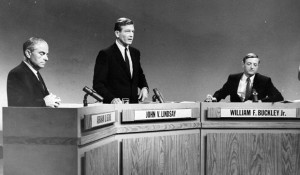Republican presidential wannabees have been claiming they are positioned to win in November because Reagan Democrats will rally behind them. They may be correct about their appeal to this mostly Catholic voting bloc. But the key question is: Can these voters still swing elections?
Disgruntled Catholic Democrats first hit the political radar in 1965. That year, the Conservative Party of New York, founded in 1962 by two Irish Catholics, ran fellow Catholic William F. Buckley Jr. for mayor against Democrat Abe Beame and the Republican candidate, John V. Lindsay. Buckley really ran in order to stop the very liberal Lindsay, a fellow Yale alumnus, by garnering the votes of Manhattan’s old-line Republicans.
Lindsay won because most of Buckley’s third-place votes (still a whopping 340,000) came from white, ethnic Catholic neighborhoods – not from Buckley’s own turf, the Upper East Side. World War II veterans, many lifelong Democrats, had deserted their party because of its left-wing drift.
Richard Nixon grasped the significance of that Buckley vote. Seeking a political comeback in 1968, Nixon agreed with his young political analyst, Kevin Phillips, that Buckley’s drawing power had been based on cultural issues:
the restless black ghetto impinged on Catholic trade unions and neighborhoods; rising taxes for escalating welfare bore down on small home-owners; soaring crime rates jeopardized blue-collar and middle-class lives.
More than any other Northeastern religious group, Catholics inhabited the socio-economic “combat zone” confronting the Democratic Party, which faced a dilemma: abandon its increasingly liberal ideological thrust or risk alienating its largest bloc of longtime supporters.
New York Catholics were not alone in their distrust of the Democratic Party’s ascendant social engineers. Ethnic Catholics in Boston, Chicago, Philadelphia, Scranton, St. Louis, and the rapidly growing suburbs were upset over many of the Great Society’s social programs. And while most of them remained registered Democrats, surveys showed their loyalty was weakening because they no longer felt party had their interests at heart.
This trend became most evident in President Nixon’s re-election. As the 1972 election results poured in, there could be no doubt that the Democratic coalition forged by Franklin Roosevelt had disintegrated. Nixon beat George McGovern, carrying forty-nine states and garnering 60 percent of the national vote.
Nixon was the first Republican to receive a majority of the Catholic vote. Poles in Detroit, Pittsburg, Buffalo, and Lackawanna; Italians in Philadelphia, Boston and Chicago; Irish in New York and Boston; Germans in St. Paul and Milwaukee, overwhelmingly endorsed Nixon.
One Italian-American Democrat in New York, Mario Cuomo, viewed the electoral wreckage and rightly concluded that McGovern had driven away the Catholic blue-collar worker, “who felt alienated by a new Democratic Party which he thought neither understood nor related to him.”
Eight years later, these “Nixon Democrats” became “Reagan Democrats.” Running against President Carter, Reagan stressed “work, family, neighborhood, peace and freedom.” He told Catholic voters:
The secret is that when the Left took over the Democratic Party we took over the Republican Party. We made the Republican Party into the Party of the working people, the family, the neighborhood, the defense of freedom, and yes, the American Flag and the Pledge of Allegiance to one Nation under God. So, you see, the Party that so may of us grew up with still exists except that today it’s called the Republican Party.
Reagan carried the Catholic vote 49 percent to Carter’s 42 percent (Independent candidate John Anderson received 7 percent), and the decade of the 1980s was the highpoint of the voting power of Catholic Reagan Democrats.
Since then there has been a steady decline.
At the end of the Second World War there were 16.1-million U.S. soldiers, 30 percent of whom were Catholic. By May 2015, 90 percent of them had died. The remaining 1.7 million are dying at the rate of 1,000 per day. The Department of Veterans Affairs projects that by September 30, 2017 that number will drop to 500,000.
My father is a classic Reagan Democrat. He joined the Marines in 1944 at age 17, was wounded in the South Pacific, returned home to work as a longshoreman on the Brooklyn piers until he joined the NYPD in 1953. My father, who, God-willing, will turn 89 in May, is on the young side of World War II veterans.
The rapidly declining number of World War II veterans helps explain in part why former swing states in presidential elections – New York, Pennsylvania, Illinois, New Jersey – have become deep blue states. Thirty years after Reagan’s smashing 1984 reelection (he won 49 states, as had Nixon in ‘72), many of his Catholic supporters are now in their nineties and have moved to Florida, or have moved on to their heavenly reward.
Catholic Reagan Democrats are simply no longer a significant voting bloc. And, sadly, many of the children and grandchildren of the “Greatest Generation” are cafeteria Catholics.
As sociologist Charles Murray pointed out in his trenchant work Coming Apart, the remaining Catholic blue-collar residents of once vibrant manufacturing towns are no longer “tightly knit, family oriented, hard-working, hard fighting” due to the declining influence of the Church and the triumph of the counter-culture.
The Republican Party must stop living in the Reagan past and recognize it must grow its base. In my judgment, its future depends on attracting Catholic Hispanics, many of whom are socially conservative, come from tight-knit families, are regular church-goers, and possess an entrepreneurial spirit.
The GOP ignores this advice at its peril, especially so if it nominates a presidential candidate who actually alienates Hispanics, at which point the party will go the way of the Whigs.















